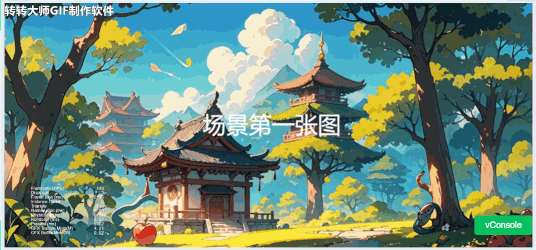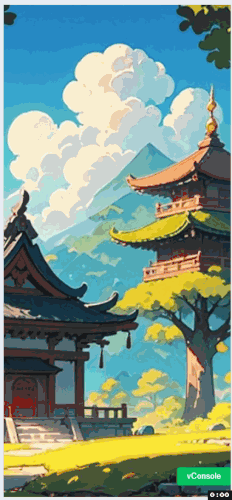引擎版本:3.7.4
看了论坛大概有两种方案:
- HTML IMG标签定一个图片,进度条什么的到场景完成,在场景里关闭隐藏。
- WEB GL渲染 基于WX
环境现状:
使用引擎3.7.4,游戏横屏,附2个DEMO末尾。麻烦大佬帮我看看啥问题。
方案一:
我用HTML IMG标签,在竖屏的状态下进入游戏,webmobile平台,会先看到竖屏再横屏显示。
html代码如下:
<div id="GameDiv" cc_exact_fit_screen="true">
<div class="custom_splash-screen" id="custom_splash-screen">
<img class="splash-screen-image" src="./splash.jpg" alt="" id="splash-screen-image">
</div>
<div id="Cocos3dGameContainer">
<!-- <canvas id="canvas" oncontextmenu="event.preventDefault()" tabindex="99"></canvas> -->
<canvas id="GameCanvas" oncontextmenu="event.preventDefault()" tabindex="99"></canvas>
</div>
</div>
CSS代码:
.custom_splash-screen {
z-index: 99;
position: absolute;
left: 0;
top: 0;
width: 100%;
height: 100%;
}
.splash-screen-image {
position: absolute;
width: 100%;
height: 100%;
top: 50%;
left: 50%;
transform: translate(-50%, -50%);
object-fit: cover;
}
其中splash.jpg是一张图横屏。
测试发现:
- 在纯横屏模式没有问题;
- 在竖屏模式,游戏启动后会先竖屏显示某一部分,然后横屏正常显示。
总觉得有些奇怪,毕竟习惯拿微信扫,或者说手机系统竖向锁定来玩游戏,看到这个情况就多少有点难接受了。
竖屏模式:
方案二:
感觉上述走不通,我尝试用webGL解决,在生成的index.html里,嵌入顶点和片段着色器代码:
代码如下:
<!-- vertex shader -->
<script id="vertex-shader-2d" type="x-shader/x-vertex">
attribute vec2 a_position;
uniform mat3 u_matrix;
uniform vec2 u_resolution;
attribute vec2 a_texCoord;
varying vec2 v_texCoord;
void main() {
// Multiply the position by the matrix.
vec2 position = (u_matrix * vec3(a_position, 1)).xy;
// convert the rectangle from pixels to 0.0 to 1.0
vec2 zeroToOne = position / u_resolution;
// convert from 0->1 to 0->2
vec2 zeroToTwo = zeroToOne * 2.0;
// convert from 0->2 to -1->+1 (clipspace)
vec2 clipSpace = zeroToTwo - 1.0;
gl_Position = vec4(clipSpace * vec2(1, -1), 0, 1);
// pass the texCoord to the fragment shader
// The GPU will interpolate this value between points.
v_texCoord = a_texCoord;
}
</script>
<!-- fragment shader -->
<script id="fragment-shader-2d" type="x-shader/x-fragment">
precision mediump float;
// our texture
//为什么u_image没有设置还能正常运行?
//全局变量默认为 0 所以 u_image 默认使用纹理单元 0 。 纹理单元 0 默认为当前活跃纹理,所以调用 bindTexture 会将纹理绑定到单元 0 。
uniform sampler2D u_image;
// the texCoords passed in from the vertex shader.
varying vec2 v_texCoord;
void main() {
// 在纹理上寻找对应颜色值
gl_FragColor = texture2D(u_image, v_texCoord);
}
</script>
<script src="https://webglfundamentals.org/webgl/resources/webgl-utils.js"></script>
<script src="./firstScreen.js"></script>
firstScreen.js部分,我取的是GameCanvas画布,直接贴代码:
"use strict";
/**
* create by kevin
* Date:2024年9月4日 17:12:31
*/
function main() {
var image = new Image();
image.src = "splash.jpg";
image.onload = function () {
render(image);
};
}
function render(image) {
var canvas = document.querySelector("#GameCanvas");
var gl = canvas.getContext("webgl");
if (!gl) {
return;
}
// setup GLSL program
var program = webglUtils.createProgramFromScripts(gl, ["vertex-shader-2d", "fragment-shader-2d"]);
// look up where the vertex data needs to go.
var positionLocation = gl.getAttribLocation(program, "a_position");
var texcoordLocation = gl.getAttribLocation(program, "a_texCoord");
var matrixLocation = gl.getUniformLocation(program, "u_matrix");
// Create a buffer to put three 2d clip space points in
var positionBuffer = gl.createBuffer();
// Bind it to ARRAY_BUFFER (think of it as ARRAY_BUFFER = positionBuffer)
gl.bindBuffer(gl.ARRAY_BUFFER, positionBuffer);
setRectangle(gl, 0, 0, image.width, image.height);
// provide texture coordinates for the rectangle.
var texcoordBuffer = gl.createBuffer();
gl.bindBuffer(gl.ARRAY_BUFFER, texcoordBuffer);
gl.bufferData(gl.ARRAY_BUFFER, new Float32Array([
0.0, 0.0,
1.0, 0.0,
0.0, 1.0,
0.0, 1.0,
1.0, 0.0,
1.0, 1.0,
]), gl.STATIC_DRAW);
// Create a texture.
var texture = gl.createTexture();
gl.bindTexture(gl.TEXTURE_2D, texture);
/**
* 这段代码是WebGL API的一部分,用于设置2D纹理对象的参数。WebGL是一个JavaScript API,用于在网页上渲染交互式3D和2D图形,无需使用插件。下面是对这段代码的解释:
gl.texParameteri(target, pname, param): 这是一个设置纹理参数的函数,其中:
target 是纹理的目标类型,这里是 gl.TEXTURE_2D,表示2D纹理。
pname 是要设置的参数的名称。
param 是要设置的参数值。
gl.TEXTURE_WRAP_S 和 gl.TEXTURE_WRAP_T: 这两个参数控制纹理在S轴(水平方向)和T轴(垂直方向)的包裹方式。设置为 gl.CLAMP_TO_EDGE 表示纹理坐标超出[0.0, 1.0]范围时,纹理将被拉伸到最近的边缘像素的颜色。
gl.TEXTURE_MIN_FILTER 和 gl.TEXTURE_MAG_FILTER: 这两个参数控制纹理的过滤方式。gl.NEAREST 表示使用最接近的纹理元素(像素)进行过滤,这通常用于点采样,可以提供最快的渲染速度,但可能在纹理放大时出现明显的锯齿。
这段代码设置了一个2D纹理,使其在纹理坐标超出边界时不重复纹理图案,而是拉伸到边缘,并使用最近邻点采样,这通常用于需要快速渲染而不追求高质量纹理效果的场景。
*/
gl.texParameteri(gl.TEXTURE_2D, gl.TEXTURE_WRAP_S, gl.CLAMP_TO_EDGE);
gl.texParameteri(gl.TEXTURE_2D, gl.TEXTURE_WRAP_T, gl.CLAMP_TO_EDGE);
gl.texParameteri(gl.TEXTURE_2D, gl.TEXTURE_MIN_FILTER, gl.NEAREST);
gl.texParameteri(gl.TEXTURE_2D, gl.TEXTURE_MAG_FILTER, gl.NEAREST);
/**
* 参数列表:
gl.TEXTURE_2D: 表示这是2D纹理。
0: 这是纹理的mipmap级别,0表示基本级别,也就是最大的图像尺寸。
gl.RGBA: 这指定了纹理的内部格式,RGBA表示纹理包含红色、绿色、蓝色和透明度通道。
gl.RGBA: 这指定了传入的数据格式,与内部格式相同,表示传入的数据包含红色、绿色、蓝色和透明度通道。
gl.UNSIGNED_BYTE: 这指定了数据类型,UNSIGNED_BYTE表示数据是以无符号字节格式提供的,这是WebGL中最常见的数据类型。
image: 这是一个HTMLImageElement对象,表示要上传到纹理的图像。
*/
gl.texImage2D(gl.TEXTURE_2D, 0, gl.RGBA, gl.RGBA, gl.UNSIGNED_BYTE, image);
// lookup uniforms
var resolutionLocation = gl.getUniformLocation(program, "u_resolution");
webglUtils.resizeCanvasToDisplaySize(gl.canvas);
// Tell WebGL how to convert from clip space to pixels
gl.viewport(0, 0, gl.canvas.width, gl.canvas.height);
// Set a rectangle the same size as the image.
var newWidth = canvas.width;
var newHight = canvas.height;
console.log("result :", newWidth, newHight);
// let ratioW = gl.canvas.width / image.width;
// let ratioH = gl.canvas.height / image.height;
// image.width = gl.canvas.width
// image.height = gl.canvas.height
// Clear the canvas
gl.clearColor(0, 0, 0, 0);
gl.clear(gl.COLOR_BUFFER_BIT);
// Tell it to use our program (pair of shaders)
gl.useProgram(program);
// Turn on the position attribute
gl.enableVertexAttribArray(positionLocation);
// Bind the position buffer.
gl.bindBuffer(gl.ARRAY_BUFFER, positionBuffer);
// Tell the position attribute how to get data out of positionBuffer (ARRAY_BUFFER)
var size = 2; // 2 components per iteration
var type = gl.FLOAT; // the data is 32bit floats
var normalize = false; // don't normalize the data
var stride = 0; // 0 = move forward size * sizeof(type) each iteration to get the next position
var offset = 0; // start at the beginning of the buffer
gl.vertexAttribPointer(
positionLocation, size, type, normalize, stride, offset);
// Turn on the texcoord attribute
gl.enableVertexAttribArray(texcoordLocation);
// bind the texcoord buffer.
gl.bindBuffer(gl.ARRAY_BUFFER, texcoordBuffer);
// Tell the texcoord attribute how to get data out of texcoordBuffer (ARRAY_BUFFER)
var size = 2; // 2 components per iteration
var type = gl.FLOAT; // the data is 32bit floats
var normalize = false; // don't normalize the data
var stride = 0; // 0 = move forward size * sizeof(type) each iteration to get the next position
var offset = 0; // start at the beginning of the buffer
gl.vertexAttribPointer(
texcoordLocation, size, type, normalize, stride, offset);
// set the resolution
gl.uniform2f(resolutionLocation, gl.canvas.width, gl.canvas.height);
let scale = [1, 1];
//计算缩放
let fixHeight = image.width > image.height;
let visibleSize = gl.canvas;
// if (fixHeight) {
// if (image.width < visibleSize.width) {
// let ratio = visibleSize.width / image.width;
// console.log("ratio width1:", ratio);
// scale = [ratio, ratio];
// }
// } else {
// if (image.height < visibleSize.height) {
// let ratio = visibleSize.height / image.height;
// console.log("ratio width2:", ratio);
// scale = [ratio, ratio];
// }
// }
let raidio = Math.max(visibleSize.width/image.width,visibleSize.height/image.height)
scale = [raidio,raidio];
//平移到屏幕中心
var translation = [gl.canvas.width / 2, gl.canvas.height / 2];
var translationMatrix = m3.translation(translation[0], translation[1]);
var scaleMatrix = m3.scaling(scale[0], scale[1]);
// make a matrix that will move the origin of the 'image' to its center.
var moveOriginMatrix = m3.translation(-image.width / 2, -image.height / 2);
var matrix = m3.multiply(translationMatrix, scaleMatrix);
matrix = m3.multiply(matrix, moveOriginMatrix);
// Set the matrix.
gl.uniformMatrix3fv(matrixLocation, false, matrix);
// Draw the rectangle.
var primitiveType = gl.TRIANGLES;
var offset = 0;
var count = 6;
console.log("开始画..");
gl.drawArrays(primitiveType, offset, count);
}
function setRectangle(gl, x, y, width, height) {
var x1 = x;
var x2 = x + width;
var y1 = y;
var y2 = y + height;
gl.bufferData(gl.ARRAY_BUFFER, new Float32Array([
x1, y1,
x2, y1,
x1, y2,
x1, y2,
x2, y1,
x2, y2,
]), gl.STATIC_DRAW);
}
var m3 = {
translation: function (tx, ty) {
return [
1, 0, 0,
0, 1, 0,
tx, ty, 1,
];
},
rotation: function (angleInRadians) {
var c = Math.cos(angleInRadians);
var s = Math.sin(angleInRadians);
return [
c, -s, 0,
s, c, 0,
0, 0, 1,
];
},
scaling: function (sx, sy) {
return [
sx, 0, 0,
0, sy, 0,
0, 0, 1,
];
},
multiply: function (a, b) {
var a00 = a[0 * 3 + 0];
var a01 = a[0 * 3 + 1];
var a02 = a[0 * 3 + 2];
var a10 = a[1 * 3 + 0];
var a11 = a[1 * 3 + 1];
var a12 = a[1 * 3 + 2];
var a20 = a[2 * 3 + 0];
var a21 = a[2 * 3 + 1];
var a22 = a[2 * 3 + 2];
var b00 = b[0 * 3 + 0];
var b01 = b[0 * 3 + 1];
var b02 = b[0 * 3 + 2];
var b10 = b[1 * 3 + 0];
var b11 = b[1 * 3 + 1];
var b12 = b[1 * 3 + 2];
var b20 = b[2 * 3 + 0];
var b21 = b[2 * 3 + 1];
var b22 = b[2 * 3 + 2];
return [
b00 * a00 + b01 * a10 + b02 * a20,
b00 * a01 + b01 * a11 + b02 * a21,
b00 * a02 + b01 * a12 + b02 * a22,
b10 * a00 + b11 * a10 + b12 * a20,
b10 * a01 + b11 * a11 + b12 * a21,
b10 * a02 + b11 * a12 + b12 * a22,
b20 * a00 + b21 * a10 + b22 * a20,
b20 * a01 + b21 * a11 + b22 * a21,
b20 * a02 + b21 * a12 + b22 * a22,
];
},
};
main();
测试如下:
- 在浏览器跑提示:This device does not support WebGL.

原因在于GameCanvas这个节点不知道为啥不支持。如果使用canvas不会有这个问题,但是会有两个画布同时显示,这就尴尬了。论坛的很多方案都是基于微信取得的微信都canvas。但我这个web-mobile平台。 - 横屏模式下没有问题,图片可以正常渲染,虽然显示了This device does not support WebGL,但是渲染后,会闪一下黑屏画面后,切入了正常的场景背景图。
- 竖屏模式依然表现糟糕:图片先竖屏显示,然后横屏,跟着再黑一下,最后显示了正常的场景背景。
横屏:

DEMO-IMG:
HelloWorld-IMG-TEST.zip (4.0 MB)
DEMO-WEBGL
HelloWorld-WEBGL-TEST.zip (4.0 MB)
求大佬看看 



